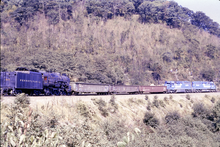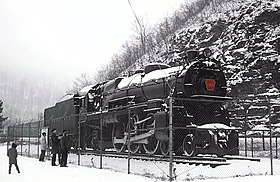|
Pennsylvania Railroad 1361
Pennsylvania Railroad 1361 is a 4-6-2 K4 "Pacific" type steam locomotive built in May 1918 by the Pennsylvania Railroad's (PRR) Juniata Shops in Altoona, Pennsylvania. It hauled mainline passenger trains in Pennsylvania and commuter trains in Central New Jersey on the PRR until its retirement from revenue service in 1956. Restored to operating condition for excursion service in 1987, No. 1361 and its only surviving sister locomotive, No. 3750, were designated as the official state steam locomotives by the Pennsylvania General Assembly. In late 1988, it was sidelined due to mechanical problems and was currently owned by the Railroaders Memorial Museum (RMM) in Altoona, Pennsylvania, who were currently getting No. 1361 back to operation. HistoryDesign changes, revenue service, and retirement as a display No. 1361 was one of 425 K4 class steam locomotives built between 1914 and 1928 for the Pennsylvania Railroad (PRR) as their standard passenger locomotive.[1][4] Built in May 1918 at PRR's Juniata Shops in Altoona, Pennsylvania, No. 1361 was assigned to haul PRR's mainline passenger trains, including the Broadway Limited, between New York City and Pittsburgh, Pennsylvania, via the PRR Main Line.[1][4] When first built, No. 1361 was originally equipped with a square oil headlight, a round number plate, a long wooden pilot, and a 70-P-75 type tender, which held 7,000 US gallons (26,000 L) of water and 12.5 tonnes (28,000 lb) of coal.[1][5] During the 1920s, No. 1361 was re-equipped with an electric headlight, a steel bar pilot, and a keystone style number plate.[5] Additionally, the PRR's express passenger trains grew longer and heavier, which led to No. 1361 and the other K4s required to double head and even triple head each other.[6][7] When the PRR's Eastern Region line between New York and Harrisburg, Pennsylvania was electrified in the 1930s, No. 1361 was relocated to the Central Division, running between Harrisburg and Pittsburgh.[1][4] Additionally, the No. 1361 locomotive was re-equipped with a 110-P-75 type tender, which held 11,980 US gallons (45,300 L) of water and 18.5 tonnes (41,000 lb) of coal along with a mechanical stoker made to increase the locomotive's performance.[1][8] After the end of World War II in 1945, No. 1361 was re-equipped with a cast steel pilot and a vertically retractable coupler along with its headlight and dynamo's positions switched from the front and top of the smokebox.[5] Additionally, a platform stand was added to the bottom front of No. 1361's smokebox for the maintenance crew to attend and inspect its headlight and dynamo.[5] In the early 1950s, 72 K4 locomotives, including No. 1361, were relocated to Central New Jersey to haul commuter trains between Perth Amboy and Bay Head, New Jersey on the New York and Long Branch line as their main line duties were taken over by the diesel locomotives.[9][10][11] During that time, No. 1361 swapped out its original 110-P-75 tender with a 130-P-75 type, which held 13,475 US gallons (51,010 L) of water and 22 tonnes (49,000 lb) of coal.[1][12] In May 1956, No. 1361 was retired from the PRR and was cosmetically refurbished to be on display next to the PRR's famous Horseshoe Curve, where it was dedicated on June 8, 1957.[11][13] It had traveled over 2,469,000 miles (3,973,000 km) during its revenue service.[4] For three decades, No. 1361 sat on display outside exposed to the elements, so the members of the Horseshoe Curve Chapter of the National Railway Historical Society (NRHS) were volunteered to repaint and maintain the locomotive.[14][15] Short excursion service On September 16, 1985, PRR's successor Conrail and Assemblyman Richard Geist removed No. 1361 from its display site and moved it to the Railroaders Memorial Museum (RMM) in Altoona for its fifth anniversary.[4][16] There were originally plans to have the locomotive cosmetically restored again, but the RMM sought to restore it to operating condition for excursion service.[4] On April 15, 1986, the restoration work of No. 1361 began at Conrail's ex-PRR Altoona Car Shop.[4][17] No. 1361's former display location at the Horseshoe Curve was taken over by an EMD GP9 diesel locomotive No. 7048, painted in PRR livery.[18][19] On April 12, 1987, the locomotive moved under its own power for the first time in 31 years and made its first excursion run from Altoona to Bellefonte, Pennsylvania.[4] It also ran excursion trains on the Nittany and Bald Eagle Railroad and Northern Central Railway.[19][20] On December 18, 1987, the Pennsylvania General Assembly designated Nos. 1361 and 3750 as the official state steam locomotives; the same bill designated the GG1 4859 as the state electric locomotive.[21] In August 1988, No. 1361 pulled an excursion on the Conrail mainline from Altoona to York, Pennsylvania, but during the return run, the locomotive suffered a main bearing and drive axle catastrophic failure near Lewistown.[4][22] As a result, No. 1361 indefinitely had to be sidelined from excursion service for a complete rebuild.[4][20][22] Second restoration attemptIn preparation for its second restoration, No. 1361's boiler shell passed an ultrasound test, but the backhead was discovered to have needed additional repairs, so the whole locomotive was disassembled inside Conrail's Altoona Car Shop.[22] The RMM subsequently made plans to spin-off ownership of No. 1361 to a newly-formed group called Keystone Restoration and Preservation, Inc. (KR&P); KR&P would gain the rights to operate No. 1361 and raise funds for it, while the museum would retain the rights to display the locomotive on their property.[22] In 1992, the National Park Service (NPS) awarded the RMM a $900,000 federal grant, which included a $420,000 grant being received from the Southwestern Pennsylvania Heritage Preservation Commission (SPHPC), and the RMM quickly prioritized the grant for No. 1361's rebuild.[22] In 1996, the No. 1361 locomotive was moved to the Steamtown National Historic Site in Scranton, Pennsylvania, for its rebuild to begin.[23] The RMM had reorganized their plans for the restoration, and they arranged to have No. 1361 restored through a partnership between them, Steamtown, and the University of Scranton.[24] But the restoration work progressed slowly, since to some its original parts needed to be replaced with fabricated duplicates.[24] Scheduled completion dates were repeatedly pushed back, and the restoration work was eventually reestimated to cost $1.7 million to complete.[25][26] In 2008, the plans to rebuild No. 1361 at the Steamtown facilities were cancelled, since the RMM stopped paying out the funds and made the decision to return the remains of the locomotive and its parts back to their property.[27] In 2010, most of No. 1361's parts, including the cab, driving wheels, frame, and tender, have returned to the RMM, but the boiler and some other parts were stored at the East Broad Top Railroad shops in Orbisonia, Pennsylvania.[20][26][28] In 2015, the museum had completed the construction of their new Harry Bennett Memorial Roundhouse to store No. 1361's boiler, tender, frame, and other part components.[20][29][30] Third restoration In May 2018, restoration hopes were renewed when former Philadelphia commissioner Bennett Levin and former Amtrak CEO Wick Moorman announced the creation of a private restoration fund.[20] No. 1361 needed a newly welded boiler, which would cost at least $1,000,000.[20] Levin and Moorman also announced that once the No. 1361 locomotive was fully restored, it will eventually pull a set of ex-PRR P70 passenger cars and B60 baggage cars for use as a demonstration exhibit train.[20] In February 2019, the group has planned to design a new boiler in order to meet the current Federal Railroad Administration (FRA) and mechanical engineering standards.[31] In October 2019, No. 1361's tender was fully repaired and upgraded with rolling bearing trucks.[32] Additionally, the tender's water scoop was restored for demonstration purposes.[32] On June 24, 2021, the museum announced that they hired the contracting firm FMW Solutions to rebuild No. 1361's boiler with a new firebox.[33][34] The total cost of the restoration work are estimated to be $2.6 million.[17][33] In October 2021, the old firebox was completely removed from No. 1361's boiler as part of FMW Solutions' total renovation.[35] In late June 2022, the construction of No. 1361's new firebox was commenced.[12] At the same time, the Pennsylvania Railroad Technical and Historical Society (PRRTHS) donated $100,512.33 to the RRM for the construction.[12][36] On October 14, 2022, the RMM went into partnership with the Western Maryland Scenic Railroad (WMSR) in Cumberland, Maryland, to run an evening fundraiser excursion being pulled by WSMR's No. 1309 steam locomotive with more than $13,000 raised to benefit No. 1361's restoration.[37][38][a] By December 2022, the new firebox was nearing completion, although with thicker steel and other modifications of the 1914 design in order to comply with current FRA safety requirements.[39] On February 13, 2023, the RMM acquired an ex-PRR B60b baggage car from the Railway Excursion Management Company for use behind the proposed No. 1361 exhibition train.[40] On May 6, 2023, during the 105th anniversary of No. 1361's construction, the RMM sponsored a fundraiser excursion on the Everett Railroad with 2-6-0 No. 11 pulling it.[41][42] That same day, a press conference meeting about No. 1361's restoration progress was held at the RMM's roundhouse.[43] In July 2023, the construction work for the new firebox was fully funded.[44] The original PRR firebox design significantly increased the cost and complexity of the work.[44] Assembly of the inner sheets is anticipated to start in August or September.[44] After completion of the firebox, the next phase is development of the work needed to mate the boiler and firebox to the frame and running gear.[44] The new boiler is being fabricated with welded rather than riveted seams.[45]: 17:04 It was announced in November 2023 that the restoration work determine the effects of this weight change on the running gear was ongoing.[45]: 18:34 The remaining work is estimated to cost at least $1.9 million and would take three years for completion.[46] In May 2024, the tender was unveiled in a new coat of paint.[47] See also
NotesReferences
Bibliography
Further reading
External linksWikimedia Commons has media related to Pennsylvania Railroad 1361.
|
||||||||||||||||||||||||||||||||||||||||||||||||||||||||||||||||||||||||||||||||||||||||||||||||||||||||||||
